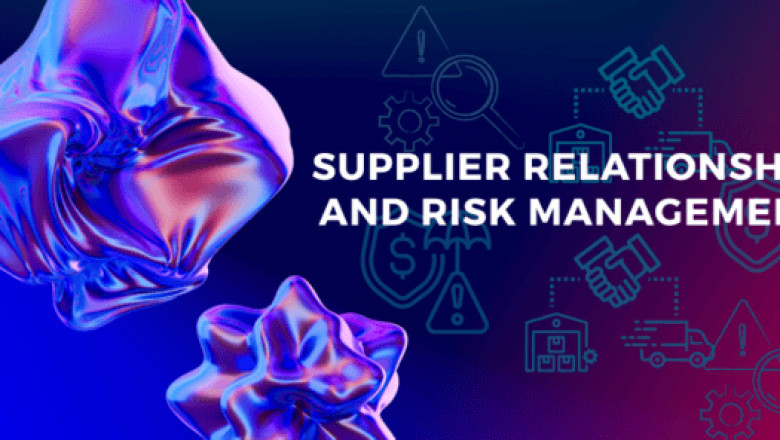views
Strengthening Business Resilience through Supplier Relationship and Risk Management
In today’s highly interconnected and globalized economy, the strength of a company’s supplier network can significantly influence its operational success and competitive advantage. Supplier Relationship and Risk Management (SRRM) has emerged as a critical function that combines the proactive cultivation of supplier partnerships with the systematic identification and mitigation of risks. For organizations seeking agility, continuity, and strategic growth, a robust SRRM approach is no longer optional—it’s a necessity.
The Dual Focus of SRRM: Collaboration and Control
At its core, Supplier Relationship and Risk Management involves two interlinked dimensions. The first is supplier relationship management, which focuses on building trust, mutual value, and collaboration with suppliers. The second is supplier risk management, aimed at identifying, assessing, and mitigating risks that can impact the supply chain, from financial and geopolitical threats to operational or reputational concerns.
By integrating both aspects, businesses can ensure not only the reliability of their supply base but also foster innovation, reduce costs, and drive sustainability goals. Strong supplier relationships create a foundation of transparency and cooperation, which is essential when navigating crises or seeking joint value creation.
Importance of Strategic Supplier Relationships
Suppliers are not just transactional vendors—they are strategic partners who can contribute to product innovation, cost efficiency, and time-to-market. Cultivating long-term relationships with key suppliers helps organizations:
- Improve collaboration on new product development.
- Ensure consistent quality and timely delivery of goods or services.
- Access new technologies and innovations earlier than competitors.
- Enhance supply chain visibility and agility during market disruptions.
These benefits are especially vital in industries with complex supply chains such as automotive, electronics, pharmaceuticals, and consumer goods.
Key Elements of Effective Supplier Relationship Management
- Segmentation and Prioritization
Not all suppliers are equal. Segmenting suppliers based on factors like criticality, spend, performance, or innovation potential helps companies prioritize relationship-building efforts. - Performance Management
Establishing Key Performance Indicators (KPIs) such as on-time delivery, quality metrics, and responsiveness ensures that suppliers meet expectations and continuously improve. - Communication and Collaboration Tools
Using centralized platforms for information sharing, contract management, and issue resolution improves transparency and collaboration across the supply chain. - Joint Development Initiatives
Collaborating with suppliers on innovation and sustainability programs enhances mutual value and strengthens long-term partnerships.
Understanding Supplier Risk Management
Supply chains face increasing risks—from natural disasters and pandemics to cyber threats, trade wars, and supplier insolvency. Supplier Risk Management focuses on preemptively identifying and mitigating such risks to avoid operational disruptions.
Risks can be broadly categorized as:
- Financial Risk: Supplier bankruptcy or cash flow problems.
- Operational Risk: Inadequate capacity, quality issues, or logistical failures.
- Compliance Risk: Violations of labor, environmental, or trade regulations.
- Geopolitical Risk: Political instability or trade sanctions.
- Cybersecurity Risk: Breaches in supplier systems that affect data or production.
Implementing a Proactive Risk Management Strategy
To effectively manage supplier risk, organizations should adopt a structured process:
- Supplier Risk Assessment
Conduct comprehensive assessments using internal audits, external ratings, and real-time data analytics to identify high-risk suppliers. - Risk Monitoring and Alerts
Use technology platforms to monitor risk indicators such as changes in credit scores, legal actions, or geopolitical shifts. Early alerts enable quicker responses. - Contingency Planning
Develop business continuity and backup sourcing plans to prepare for potential disruptions. - Compliance and Governance
Ensure all suppliers comply with ethical sourcing, regulatory requirements, and cybersecurity protocols. - Supplier Development and Diversification
Work with at-risk suppliers to improve their resilience or diversify the supplier base to reduce dependency on a single source.
Technology as an Enabler
Advanced technologies like Artificial Intelligence (AI), Blockchain, and Predictive Analytics play a vital role in enhancing SRRM capabilities. AI-driven platforms can assess large datasets to detect supplier performance trends and potential risks. Blockchain enhances transparency and traceability across complex supply networks. Predictive analytics help forecast disruptions and model risk scenarios.
These digital tools empower procurement and supply chain teams with actionable insights, allowing faster decision-making and proactive risk mitigation.
The Strategic Payoff
Investing in Supplier Relationship and Risk Management delivers significant strategic advantages. Organizations that excel in SRRM can:
- Minimize disruptions and maintain business continuity.
- Foster supplier-led innovation.
- Reduce procurement costs through better negotiations and collaboration.
- Improve ESG (Environmental, Social, and Governance) compliance.
- Strengthen their brand reputation and trust with stakeholders.
In a volatile and complex world, companies that treat their suppliers as strategic assets and manage associated risks systematically are better positioned to outperform competitors and achieve long-term resilience.
Conclusion
Supplier Relationship and Risk Management is not just about avoiding problems—it’s about unlocking opportunities. By nurturing strong partnerships and actively managing risks, organizations can transform their supply chains into a strategic advantage that fuels innovation, resilience, and sustainable growth.
#SupplierManagement #SupplyChainRisk #VendorRiskManagement #SRRM #SupplyChainStrategy






















Comments
0 comment